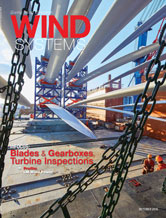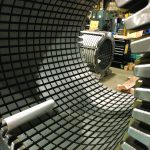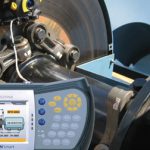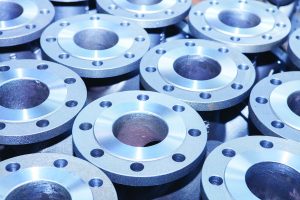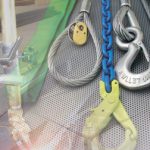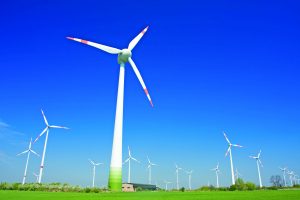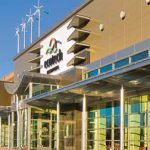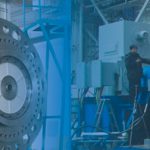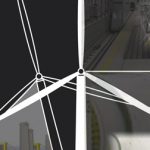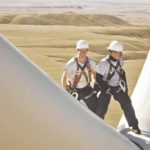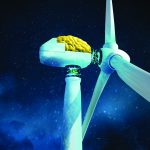LM Wind Power is not content with just supplying wind-turbine blades to make the world’s energy supply greener and cleaner.
It wants to make the process that manufactures those blades cleaner as well.
“We are proud of our contribution to a cleaner world, but also we recognize that the manufacturing process comes with a footprint, and we are determined to become leaner, greener, and cleaner throughout our operations,” said Christopher Springham, vice president of Communications, Human Resources, and Sustainability.
LM Wind Power has been making turbine blades since 1978, and with wind’s future still going strong, the company continues to make big strides in the industry.
And those big strides are quite literal.
In June, the company broke the record for the world’s longest blade at 88.4 meters.
The component was designed for Adwen’s AD 8-180 wind-turbine model, with 8 MW nominal capacity and a 180-meter rotor diameter.
The first of these massive blades was manufactured at LM Wind Power’s Pilot Plant in Lunderskov, Denmark. Later, it was transported to a facility in Aalborg for testing.
“Creating a blade on this scale presents a large step towards lowering the cost of energy from offshore wind,” Springham said.
LM Wind Power has a history of breaking size records. The LM 61.5 P was the world’s first blade to surpass the 60-meter mark in 2004. It was followed by the LM 73.5 in 2011.
The LM 88.4 P dwarves these blades by comparison — in fact, the LM 73.5 P could easily fit inside it, according to Springham.
LM Wind Power is a pioneer in offshore wind with a proven track record that dates back to the early offshore wind projects.
Recently, it has had a hand in the construction of the Block Island Wind Farm off the coast of Rhode Island, the first offshore wind facility in the U.S.
The wind farm will be powered by 15 LM 73.5-meter blades,
manufactured by LM Wind Power for GE’s 6 MW Haliade turbine.
Design Challenges
LM Wind Power’s fundamental blade constant — two fiberglass shells attached to rigid webs — has not changed since it began producing blades almost 40 years ago.
“For our new generation of blades, finding the perfect balance between aerodynamics and structure presents the greatest design challenge for each blade type,” Springham said.
Aerodynamic properties are crucial in determining how well a blade can extract energy from the wind. LM Wind Power has developed considerable expertise in calculating blade geometry and optimizing performance, according to Springham. The structure defines the modular units of the blade that are assembled to provide maximum strength and rigidity without adding too much weight. These blades are then produced all over the world, enabled by LM Wind Power’s high-quality, global-manufacturing footprint.
“Our wind-turbine blades are advanced creations: designed, manufactured, and validated with cutting-edge tools to ensure they can endure the forces of nature for more than 20 years,” Springham said. “We constantly work on new technologies to both enhance performance and push the limits on wind-farm location.”
Innovative Ideas
LM Wind Power achieves this with innovation, deeply embedded in the company’s DNA.
With that in mind, the company has developed many patents that have allowed it to push the cutting edge of blade technology.
“We received our first patent way back in 1968 for a special conveyor used to transfer live fish into a lorry,” Springham said. “This history of innovation continues today. Since beginning to develop wind-turbine blades in 1978, we have patented more than 250 inventions.”
In addition to new blade types, LM Wind Power also introduced new technologies to enhance Annual Energy Production, reduce noise, and improve blade reliability. Most of its current patents deal with lightning protection, blade aerodynamics, blade and rotor design, production technology, blade monitoring systems, service and inspection systems, and logistics.
“Pre-Bend” Technology
One of LM Wind Power’s well-known and visible patents is the blade “pre-bend” — a design characteristic that distinguishes LM blades, according to Springham.
Some blade manufacturers develop straight-and-stiff blades in order to avoid tower strikes in heavy winds. By pre-bending blades, LM Wind Power can build blades that are already bendable and a little less stiff than other blade models. This allows for savings on the cost of materials to build the blade and ultimately contributes to reducing the cost of wind energy.
“The cost of wind energy has reduced by 10 percent every decade since we began manufacturing wind-turbine blades,” Springham said. “Today, we are focused on one goal: ensuring that we achieve cost parity with all forms of energy — including renewables, oil, gas, and nuclear — without subsidy and in the most sustainable way possible. We have already reached this crucial point in certain wind markets with certain products, and together with our customers and suppliers, we innovate constantly to drive costs down still further.”
LM Wind Power is constantly working on new technologies to enhance performance and push the limits on wind farms. Some examples include the SafeReceptor Insulated Lightning Protection System, high performance leading-edge protection, advanced monitoring systems, de-icing and aerodynamic add-on features, and many more products in the pipeline, according to Springham.
Many innovations originate in LM Wind Power’s global R&D centers in Denmark, the Netherlands, and India staffed by more than 240 engineers, but that innovation is not limited to products, Springham said.
“Innovation for us is holistic, but with a firm focus on making wind compelling, competitive, and cost effective,” he said.
The Beginning
And it all started with a business that had nothing to do with wind.
LM Wind Power began life in 1940 as Lunderskov Møbelfabrik (which translates into Lunderskov Furniture Factory). It was founded by Ejner Lorentzen and Aage Skouboe as a wooden furniture factory in the small town of Lunderskov, Denmark.
Not soon after, the founders began to experiment with fiberglass in the early 1950s.
In 1953, Lunderskov Møbelfabrik divided into LM Camping and LM Glasfiber. Lorentzen was in charge of LM Camping, and Aage Skouboe led LM Glasfiber. The two divisions collaborated to create LM Caravans, which combined a fiberglass exterior with solid carpentry work in the interior. Out of the 300 caravans built, some are still being used today, according to Springham.
During that time, LM Glasfiber primarily focused on fiberglass boats, while also marketing a variety of other fiberglass items. For example, LM fish boxes were used to transport live fish by truck instead of in wooden barrels by train. A small production of speedboats began in 1954, followed by minor leisure boats and, finally, the production of the well-known LM sailboats in 1969. The LM 27 became Europe’s most-produced motor sailor at the time.
Moving Into Wind
With this intrinsic knowledge of advanced materials and a hard-earned understanding of the principles of wind energy, LM Wind Power became a market leader in wind-turbine blades. Soon after 2000, Doughty Hanson, a European private equity firm, supported the continued expansion of the company’s global manufacturing footprint.
The company officially became LM Wind Power in 2010.
“We chose to retain our initials as a tribute to our rich legacy as LM Glasfiber, but also as a gentle reminder of where we began,” Springham said. “Wind power is what we deliver, and our name represents that contribution.”
Wind remains one of the most economically attractive forms of renewable energy for large-scale electricity generation. It is expected to develop even further as offshore opportunities become a key growth segment as traditional markets stabilize.
“We are confident that the future is bright for LM Wind Power and the wind industry,” Springham said.
Following a strong performance in 2015, LM Wind Power is committed to capitalizing on the strong demand for its products, while further reducing the cost of wind energy.
“In doing so, we will further drive the top-line and improve the bottom-line result,” Springham said. “A revised corporate strategy is already in place which clearly defines our path to achieve that success in the future.”
LM Wind Power wants to reduce the cost of wind energy in order to serve the whole global economy, but ultimately, that goal represents the chance to light up the world for the 1.3 billion people who don’t have access to clean, affordable electricity.
“We believe that as we succeed, we will, quite literally, change their world for the better,” Springham said.




















